Click image for BBB rating
See our Privacy Policy
cool="cool" width="786" height="5810" border="0" cellpadding="0" cellspacing="0" gridx="16" showgridx="showgridx" usegridx="usegridx" gridy="16" showgridy="showgridy" usegridy="usegridy" bgcolor="#99ccff">
|
|
|
 |
|
|
|
|
|
|
|
Welcome to Spaightwood Galleries, Inc.
120 Main Street, Upton MA 01568-6193
|
|
|
|
|
William Blake created an art unlike any other English artist of the late 18th or 19th centuries, but what could one expect from a man who saw visions of Heaven and Hell on earth and lived surrounded by angels and devils? The first study of William Blake was published in 1863. Written by Alexander Gilchrist, who died while the book was still in the process of being printed, it proclaims its subject in its title: The Life of William Blake, 'Pictor Ignotus.' Unknown Painter indeed! Blake must have been pretty much an unknown painter outside the very small circle of those who patronized his one-of-a kind illustrated books and his mystical writings. Since then, however, he has come to be recognized as a very important poet and an equally important artist. Of special interest to us here, however, is the note added at the end of the second volume, which included a number of his poems and of his illustrations (reproductions of his designs for The Book of Job and relief etchings from Songs of Innocence and Experience). The Job illustrations are outside our purview here; however, the works for the Songs are of special interest thanks to a note added by the poet Dante Gabriel Rosetti at the end of the section of illustrations that tells us that the illustrations were made from Blake's "original plates, recovered by Mr. Gilchrist, being the only remnant of the series still in existence on copper; the rest having, it is believed, been stolen after Blake's death, and sold for old metal." The works are printed on off-white paper in brownish ink. It is with these 15 works made directly from Blake's plates that we will be immediately concerned on this and the following webpage.
The standard catalogue raisonné of Blake's prints is David Bindman, The Complete Graphic Works of WIlliam Blake (London: Thames & Hudson, 1978); we shall refer to it for each of the pieces that follow. An easily available work introducing the Songs of Innocence and of Experience is the facsimile published by Oxford University Press in 1970. This life-size facsimile of one of the individually hand-colored sets of the prints with an Introduction and Commentary by Sir Geoffrey Keynes (first published by the Trianon Press in Paris in 1967) is the easiest entry into the world of Blake's Songs, which were originally done for specific buyers, hand-painted by Blake in whatever order seemed best to him at the moment until he finally finished all of the plates and fixed an order for the 55 plates in the final sequence. The number of copies is unknown but very small: a late copy colored only in black washes came up for auction several years ago with an estimated price of Please call or email for current pricing information-Please call or email for current pricing information.
|
|
|
|
|
|
|
|
|
|
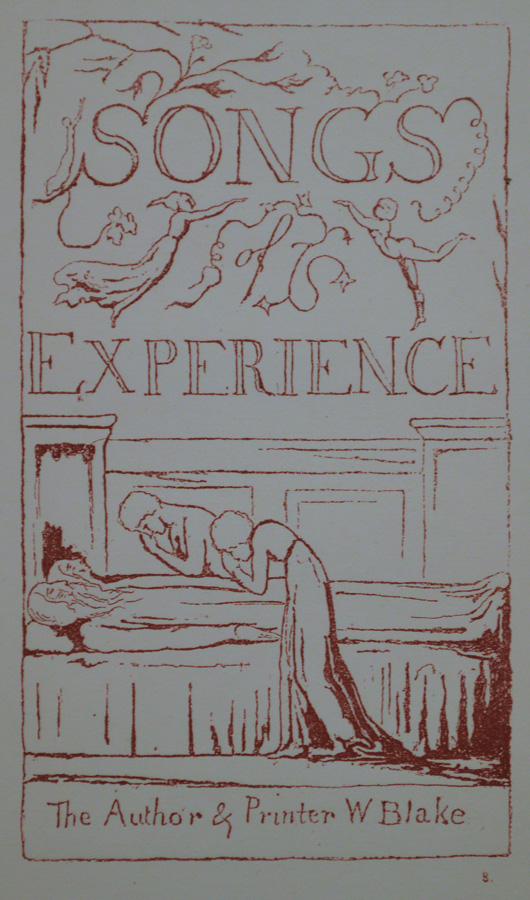 |
|
Songs of Experience (Bindman 243). Original relief etching, 1794. Published 1863 in an edition of unknown size by Macmillan and Co. (London and Cambridge). This work was printed from Blake's own plates (and they constitute the only surving plates remaining from the Songs of Innocence and Experience). As Dante Gabriel Rosetti notes in his afterword, they are "therefore as absolutely the originals as those appearing in the copies printed by Blake." There were at least 2 later editions, but they seem to have been made not from the original plates but from plates made from the original plates. The edition was presumably small, because Blake was a completely forgotten poet/artist at the time of its publication.
In his introduction, Sir Geoffrey comments about the two sequences: "There is no reason for thinking tha when he composed the Songs of Innocence that he had already envisaged a second set of antithetical poems embodying Experience. The Innocence poems were the products of a mind in a state of innocence and an imagination unspoiled by stains of worldliness. Public events and private emotions soon converted Innocence into Experience, producing Blake's preoccupation with the problem of Good and Evil. This, with his feelings of indignation and pity for the suffereings of mankind as he sae them in the streets of London, resulted in his composing the second set" (p. 12). Image size: 113x73mm. Price: Please call or email for current pricing information.
|
|
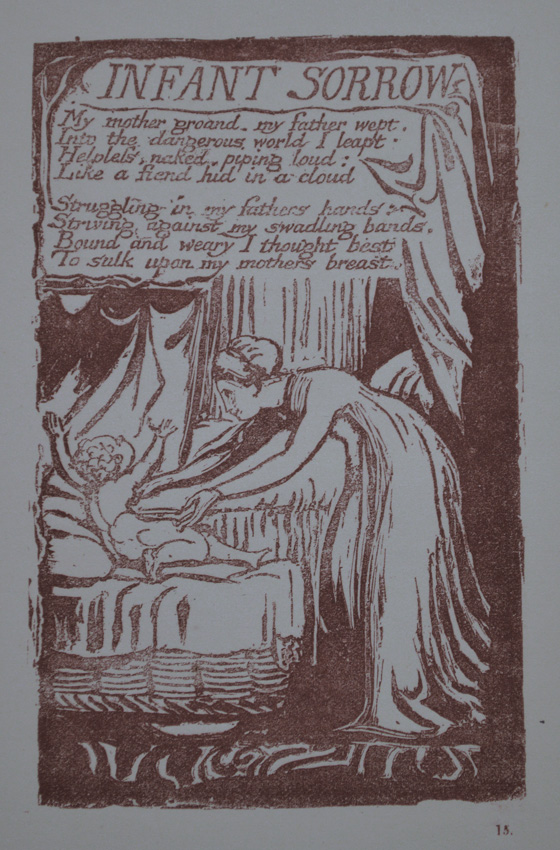 |
|
|
|
Infant Sorrow (Bindman 246). Original relief etching, 1794. Published 1863 in an edition of unknown size by Macmillan and Co. (London and Cambridge). This work was printed from Blake's own plates (and they constitute the only surving plates remaining from the Songs of Innocence and Experience). As Dante Gabriel Rosetti notes in his afterword, they are "therefore as absolutely the originals as those appearing in the copies printed by Blake." There were at least 2 later editions, but they seem to have been made not from the original plates but from plates made from the original plates. Image size: 111x71mm. Price: Please call or email for current pricing information.
My mother groand! my father wept.
Into the dangerous world I leapt:
Helpless, naked, piping loud:
Like a fiend hid in a cloud.
Struggling in my fathers hands:
Striving against my swadling bands:
Bound and weary I thought best
To sulk upon my mothers breast.
|
|
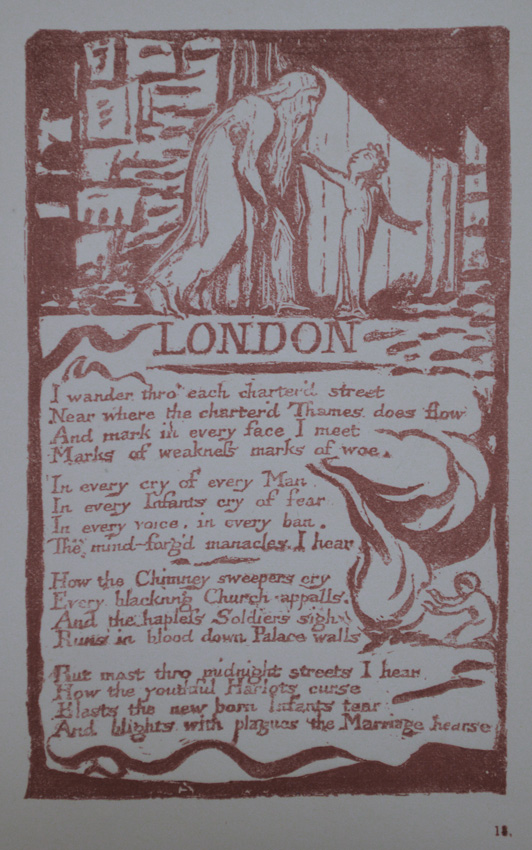 |
|
|
London (Bindman 249). Original relief etching, 1794. Published 1863 in an edition of unknown size by Macmillan and Co. (London and Cambridge). This work was printed from Blake's own plates (and they constitute the only surving plates remaining from the Songs of Innocence and Experience). As Dante Gabriel Rosetti notes in his afterword, they are "therefore as absolutely the originals as those appearing in the copies printed by Blake." There were at least 2 later editions, but they seem to have been made not from the original plates but from plates made from the original plates. Image size: 111x70mm. Price: Please call or email for current pricing information.
This is one of the most despairing of the Songs of Expertience:
I wander thro' each charter'd street,
Near where the charter's Thames does flow
And mark in every face I meet
Marks of weakness, marks of woe.
In every cry of every of every Man
In every Infants cry of fear,
In every voice; in every ban,
The mind-forg'd manacles I hear
How the Chimney-sweepers cry
Every blackning Church appalls,
And the hapless Soldiers sigh
Runs in blood down Palace walls
But most thro' midneight streets I hear
How the youthfull Harlots curse
Blasts the new-born Infants tear
And blights with plagues the Marriage hearse
|
|
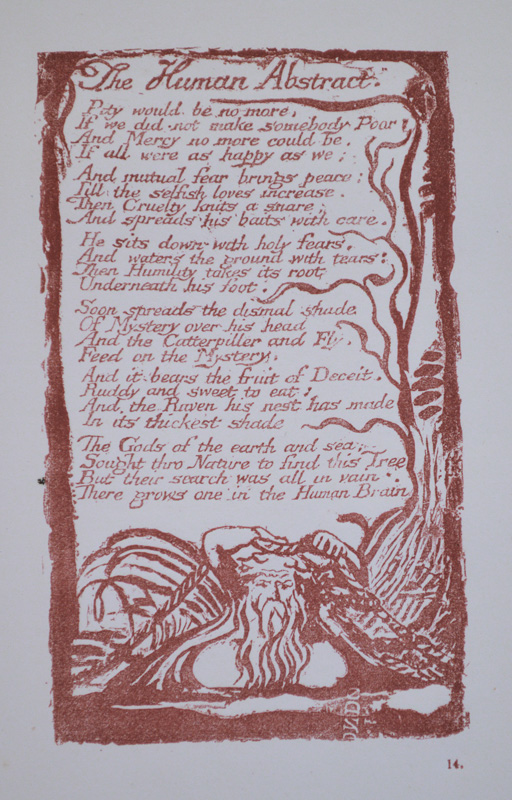 |
|
|
|
|
The Human Abstract (Bindman 251). Original relief etching, 1794. Published 1863 in an edition of unknown size by Macmillan and Co. (London and Cambridge). This work was printed from Blake's own plates (and they constitute the only surving plates remaining from the Songs of Innocence and Experience). As Dante Gabriel Rosetti notes in his afterword, they are "therefore as absolutely the originals as those appearing in the copies printed by Blake." There were at least 2 later editions, but they seem to have been made not from the original plates but from plates made from the original plates. Image size: 119x65mm. Price: Please call or email for current pricing information.
|
|
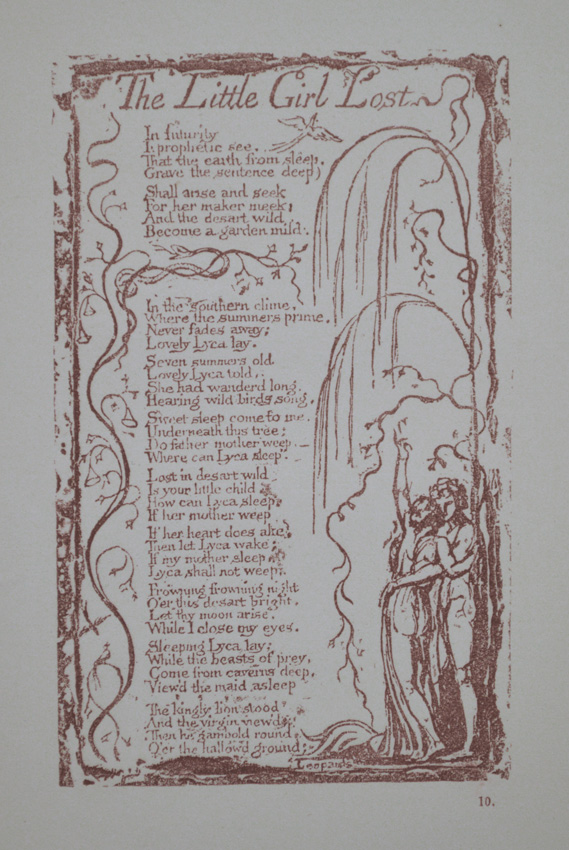 |
|
|
|
The Little Girl Lost (Bindman 253). Original relief etching, 1794. Published 1863 in an edition of unknown size by Macmillan and Co. (London and Cambridge). This work was printed from Blake's own plates (and they constitute the only surving plates remaining from the Songs of Innocence and Experience). As Dante Gabriel Rosetti notes in his afterword, they are "therefore as absolutely the originals as those appearing in the copies printed by Blake." There were at least 2 later editions, but they seem to have been made not from the original plates but from plates made from the original plates. Image size: 115x72mm. Price: Please call or email for current pricing information.
|
|
 |
|
|
|
The Little Girl Found, second plate (Bindman 255). Original relief etching, 1794. Published 1863 in an edition of unknown size by Macmillan and Co. (London and Cambridge). This work was printed from Blake's own plates (and they constitute the only surving plates remaining from the Songs of Innocence and Experience). As Dante Gabriel Rosetti notes in his afterword, they are "therefore as absolutely the originals as those appearing in the copies printed by Blake." There were at least 2 later editions, but they seem to have been made not from the original plates but from plates made from the original plates. Image size: 111x70mm. Price: Please call or email for current pricing information.
|
|
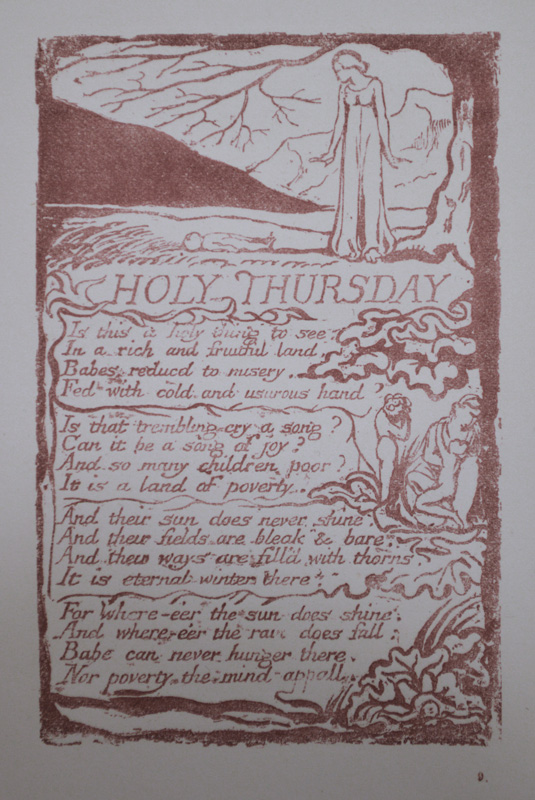 |
Holy Thursday (Bindman 264). Original relief etching, 1794. Published 1863 in an edition of unknown size by Macmillan and Co. (London and Cambridge). This work was printed from Blake'1s own plates (and they constitute the only surving plates remaining from the Songs of Innocence and Experience). As Dante Gabriel Rosetti notes in his afterword, they are "therefore as absolutely the originals as those appearing in the copies printed by Blake." There were at least 2 later editions, but they seem to have been made not from the original plates but from plates made from the original plates. Image size: 113x73mm. Price: Please call or email for current pricing information.
Holy Thursday is Blake's outraged cry for social justice and Christian love:
Is this a holy thing to see:
In a rich and fruitful land,
Babes, reduced to misery,
Fed with cold and usurous hand?
Is that trembling cry a song?
Can it be a song of joy?
And so many children poor?
It is a land of poverty.
And their sun does never shine
And their fields are bleak and bare
And their ways are filled with thorns
It is eternal winters there.
For where-eer the sun does shine
And where-eer the rain does fall:
Babe can never hunger there
Nor poverty the mind appall.
|
|
|
According to Bindman (p. 485), Blake's wood-engravings for Thornton's Virgil "are Blake's only surviving works in that medium. . . . Thornton's work was intended as a schoolbook, and Blake's engravings are part of a total of 230 wodcuts. . . . The engravings were made originally in blocks in sets of four, but these were divided for publication and, unfortuately, at the same time cut down. . . . [T]he woodcuts are often unevenly printed." Our two impressions come from the 1863 edition of Gilchrist's Life of William Blake, 'Pictor Ignotus.'
|
|
|
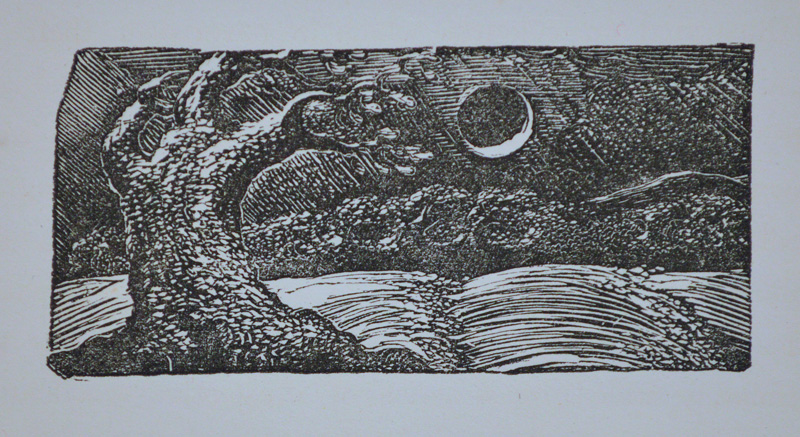 |
|
|
|
|
Blasted tree and flattened crops (Bindman 607). Original wood-engraving for Thornton's Virgil (1821). Our impression comes from the 1863 first edition of Gilchrist's Life of WIlliam Blake. Image size: 34x73mm. Price: Please call or email for current pricing information.
|
|
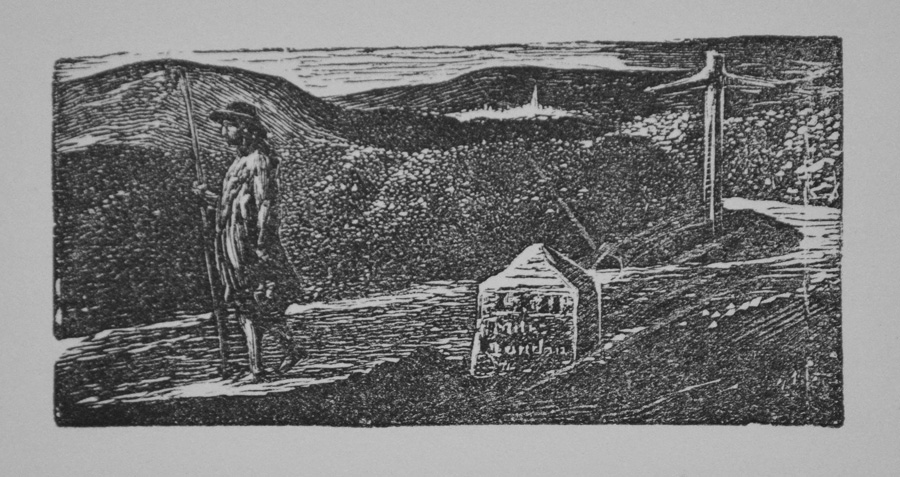 |
|
|
|
Colinet's journey: milestone marked 'LXII miles to London' (Bindman 610). Original wood-engraving for Thornton's Virgil (1821). Our impression comes from the 1863 first edition of Gilchrist's Life of WIlliam Blake. Image size: 35x74mm. Price: Please call or email for current pricing information.
|
|
|
Spaightwood Galleries, Inc.
To purchase, call us at 1-800-809-3343 (1-508-529-2511 in Upton MA & vicinity) or send an email to spaightwood@gmail.com.
We accept AmericanExpress, DiscoverCard, MasterCard, and Visa.
We also accept wire transfers and paypal.
For directions and visiting information, please call. We are, of course, always available over the web and by telephone (see above for contact information). Click the following for links to past shows and artists. For a visual tour of the gallery, please click here. For information about Andy Weiner and Sonja Hansard-Weiner, please click here. For a list of special offers currently available, see Specials.
All works are sold with an unconditional guarantee of authenticity (as described in our website listing).
Go back to the top of this page.
Visiting hours: Saturday 10:00 am to 5:00 pm and Sunday noon to 6:00 pm and other times by arrangement.
Please call to confirm your visit. Browsers and guests are welcome.
|
|
|
|
|
|
|
|
|
|
|
|
|
|
|
|
|
|
|
|
|
|
|
|
|
|
|
|
|
|
|
|








